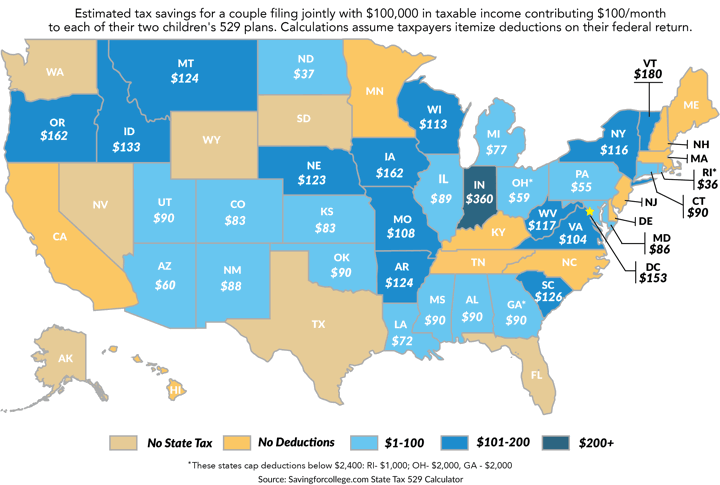Amongst the many things to consider at years-end is a contribution to a 529 college savings account. (I just made my contribution for kid #3.) In addition to the federal tax-free growth towards qualified college expenses, more than 30 out of 50 states offer some level of tax deductions for 529 contributions. Some require you to contribute to the official in-state plan, while others let you contribute to any plan.
SavingForCollege.com offers a visual comparison of these state tax benefits in the following infographic. They assume a couple filing jointly with a $100,000 taxable income and contributing $100/month for each of two children. The darker the blue, the bigger the benefit. This is the chart as of this writing, December 2017:

This may not apply exactly to your situation, but it can still provide you a quick take as to whether you should investigate further. They do have a calculator that churns out specific numbers, but unfortunately you must pay for a premium subscription. Here are some related posts:
 The Best Credit Card Bonus Offers – 2025
The Best Credit Card Bonus Offers – 2025 Big List of Free Stocks from Brokerage Apps
Big List of Free Stocks from Brokerage Apps Best Interest Rates on Cash - 2025
Best Interest Rates on Cash - 2025 Free Credit Scores x 3 + Free Credit Monitoring
Free Credit Scores x 3 + Free Credit Monitoring Best No Fee 0% APR Balance Transfer Offers
Best No Fee 0% APR Balance Transfer Offers Little-Known Cellular Data Plans That Can Save Big Money
Little-Known Cellular Data Plans That Can Save Big Money How To Haggle Your Cable or Direct TV Bill
How To Haggle Your Cable or Direct TV Bill Big List of Free Consumer Data Reports (Credit, Rent, Work)
Big List of Free Consumer Data Reports (Credit, Rent, Work)
Many of the states limit the tax deduction. If you contribute considerably more than $200/month, the above map drastically changes.
Several examples:
Calculator: https://vanguard.wealthmsi.com/stdc.php#results
Assumptions:
Taxable Income: $100,000 /yr
Contributions: $20,000/yr
Arkansas: $517
Idaho: $666
Indiana: $750
Minnesota: $159
Montana: $310
Nebraska: $513
New York: $484
Oregon: $314
South Carolina: $1050
Virginia: $172
West Virginia: $975
Wisconsin: $148
That is a valid point. I do think that $2,400 a year in contributions is much more common than $20,000 a year, however. It is unlikely that a state would want to subsidize/incentivize college savings up to that level.
That calculator doesn’t account for Virginia allowing $4,000 in deductions per account, not per account holder or beneficiary like other states. For a married couple filing jointly with two children, they can deduct $32,000 if they spread it across 8 accounts, 4 with CollegeAmerica and 4 with Invest529 (1 account per child/adult/broker). At the typical 5.75% income tax rate in Virginia, that amounts to $1,840 saved.
So for high contributors, I’m pretty certain Virginia has the best deal going in regards to state income tax breaks for its own citizens. (Also look at Morningstar ratings as documented in other posts on this site – both of Virginia’s plans are top rated.) Unfortunately, I’m told by my financial adviser that relatively few citizens take advantage of these tax breaks.
Jonathan, the map you posted with this post is inaccurate. There is no deduction in Minnesota. It appears correct at the link you provided (https://www.savingforcollege.com/articles/how-much-is-your-states-529-plan-tax-deduction-really-worth).
Strange, they must have just updated it! Thanks.
It’s despicable to see how little importance education gets in the eyes of the policy makers, especially in light of current student loan crisis.
Jonathan,
I’d be interested in your thoughts on prioritizing 529 contributions for Indiana residents (most generous state per the map). Indiana offers a 20% credit on up to $5k in contributions (thus, a $5k contribution only costs you $4k). Let’s say you get your full employer match and max out your HSA and plan to pay for your kids’ college. Would you go to 529 next (up to the $1k match) or would your prioritize additional contributions to employer plan/IRA?
That’s a tough question. Overall, I would prioritizer personal retirement needs over children’s college tuition needs. I would say it would depend on how much a “full employer match” turns out to be. For example, if it’s just 3% of $50,000, then I would probably focus on retirement funding. If you are comfortably on track for retirement and you want to fund college too and you think you’ll have too many assets for significant aid, then you should go for the 529 tax deduction.
(Keep in mind that the $1,000 state tax credit means technically you might have less to deduct on your federal taxes, as suggested by the calculator linked in the first comment. Tax law for next year may change of course…)